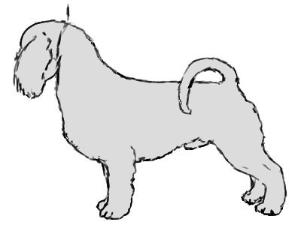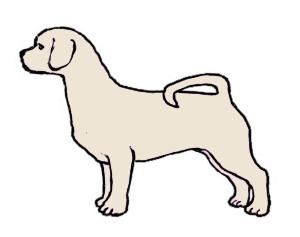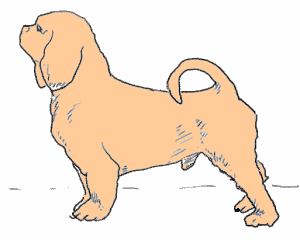
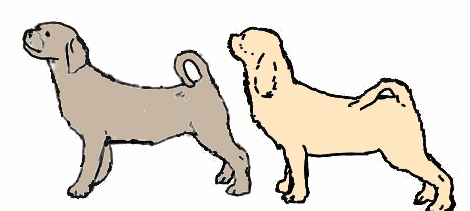
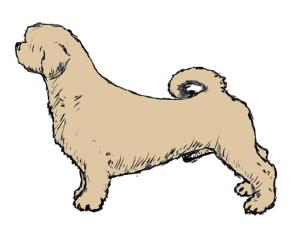
| Body | |
|
|
|
| Body. There is a tendency in England to look for a level top and a short back. All the best specimens have a slight arch at the loin and the back should not be too short; it should be considerably longer than the height at the withers. The dog should be well ribbed up, with a strong loin and well developed quarters and thighs. | Body Shape - The length from point of shoulders to point of buttocks longer than height at withers, well ribbed up, strong loin, well developed quarters and thighs. |
The Lhasa has evolved the body shape that enables him to survive in Tibet. He is of necessity a rectangular dog. Heat conservation demands two things: that muscle mass be maximized for heat production, and that appendages be kept as short as possible to minimize heat loss. A rectangular outline allows heat conservation and also the needed length of body to accommodate large lungs for respiration at high altitude. The Lhasa Apso is not a dog with an elongated body, but one with slightly shortened legs. His neck and head are proportional to his body length in the same ratio as taller breeds.
Because of the altitude, the lungs have to be voluminous for the size of the dog, and capable of considerable expansion. The best shaped chest for this purpose is not a barrel, which lacks the ability to expand, but rather a moderately rounded chest with long slanting ribs. Chest capacity is achieved by elongation of the chest cavity rather than by assuming a barrel shape. Some people are extremely critical of the "long, low" Lhasa Apso. The fact remains that this animal achieves its high altitude breathing capacity through elongation of its body. Thus the "short back" so sought after by some breeders is a type feature of low altitude creatures, and not suitable for a small Himalayan dog.
Extreme body length however, increases surface area and heat loss. The tendency to excessive elongation (for respiratory capacity) is held in check by the need to conserve heat. The Lhasa body shape is the result of a beautifully balanced series of compromises, modified by the constraints of the environment, and avoids all extremes.
As mentioned earlier, the show ring has tended to change the shape of the dog to a taller, shorter bodied type. In accomplishing this change, essential heat producing mass has often been sacrificed, along with the length of ribcage so necessary to survival in the animal's native environment. Although a very long body carries with it heavy bone, inconsistent with the breed's agility, a very short body will not have enough rib length or mass to be consistent with survival in the Himalayas. In the an otherwise well balanced Lhasa Apso, "long-bodied" should not carry the negative connotation it often does among the "show breeders".
Rugged terrain requires good jumping equipment. Particularly regrettable is the loss of the "arched loin" statement found in the 1901 standard. The keystone arch is what imparts strength to the loin segment of the back, and a strong, muscular loin is essential to efficient movement. From the heat requirement, we already know the dog must be relatively massive, mainly from muscle. However the need for efficiency (no excess baggage) and agility (a clumsy mountain animal doesn't last long) limits the amount of mass. The compromise is a dog that has more muscle than normal for its size (feels heavier than expected) and at the same time has less (and shorter) bone than is "normal" for that amount of muscle. In short, Apsos, like the people of the Himalaya, are robust and sturdy, yet small, tough and agile.
While the standard is silent on the subject of movement, the environment dictates an efficient and economical gait, a trait shared by of other mountain animals. At home, as a companion and guardian, the Lhasa likes to perch on a high wall where he can watch for intruders. However, when traveling with his human, the Lhasa Apso is quite capable of covering long distances over rocky mountain passes, running ahead of the slower yaks and horses. He proceeds by leaps and bounds, picking his way slowly where necessary, and galloping for short stretches. His hind quarter must be built for leaping and pivoting, capable of placing his hind feet well under his body, and should include a moderate bend of stifle. His loin must be strong and very flexible, never weak or hollowed, and the croup moderately (normally) angled, not flat or tipped up. (A knowledgeable horseman, buying a hunter, looks for a good rounded croup, and rejects an "Arabian" type, with a flat croup better suited to the trot.)
When the Apso does trot, we want to see the most economical gait possible. The typical trot of a wild canine represents the most efficient ground covering gait. These animals all single-track. Some Apsos, with their slightly shortened legs, and greater relative mass, may not achieve a perfect single track, but we do not want to see a wide-based bouncing or rolling gait more typical of Chinese breeds.
The modern show ring has tended to standardize gait for all breeds to
"that gait which looks best moving in a small level circle at a fast trot".
The trot is probably not the native gait for an animal that spends most
of its time walking or leaping. While no one could object if a correctly
built Lhasa also has a spectacular gait at the trot, this has very little
to do with being the best (typiest) Lhasa. The Lhasa Apso should give the
impression of moving effortlessly, in a smooth, workmanlike manner, without
bouncing, pounding, rolling or excessive rear kick-up. Strength, agility,
surefootedness, endurance, and economy of movement are the hallmarks of
the Lhasa. Exaggerated action in any gait is atypical because it wastes
energy, a potentially lethal problem at extreme altitude and temperature.



